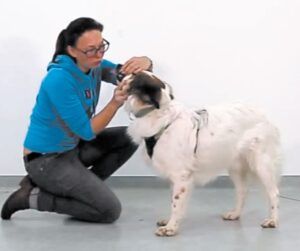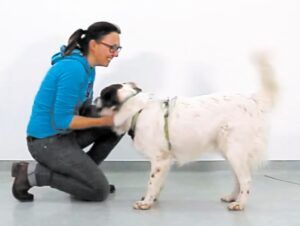More than 50 years ago the father of the Attachment Theory, John Bowlby, observed that “in most young children the mere sight of [their] mother holding another baby in her arms is enough to elicit strong attachment behavior.” Such behavior, documented in research on children as young as 6 months old, includes trying to get physically closer to the mother and facial expressions indicating a decrease in joy.

First photo: In the University of Vienna study, when someone interacted with a dog as if she were performing a veterinary exam, her own dog (watching from an MRI machine) didn’t have much of a reaction.
Could the same alarm and dismay apply to dogs who see their human “moms” and “dads” treat another dog affectionately? It’s reasonable to wonder considering several studies have suggested that the human-dog relationship resembles the mother-child bond. Dogs, like babies, form strong attachments to their “parents,” for whom they are dependent on all their needs.
To test the hypothesis, researchers at the University of Veterinary Medicine Vienna and their colleagues in other departments at the University of Vienna had a dozen dogs watch videos of their caretakers in two different situations. In one, their people were greeting and petting another dog affectionately. In the other, they were examining the other dog’s ears and teeth without emotion, as a veterinarian might do. The dogs also watched videos of a stranger treating the dog either with warmth or clinically.
During each viewing, the dogs lay quietly in magnetic resonance imaging machines, which

they had previously been taught to do. (They could leave the scanner any time they wanted by descending a custom-built ramp the researchers had rigged.) Because the animals were able to remain still, the machine could pick up good images of the blood flow in their brains, showing which parts of that organ lit up in response to what the dogs were viewing.
How the dogs reacted
The researchers found that when the dogs watched a stranger interact with another dog, blood flow increased to those parts of their brains related to sight and the processing of movement. In other words, their reaction did not appear to elicit an emotional response. Watching their caregivers give a strange dog a veterinary-like exam didn’t particularly light up brain centers associated with emotions, either. But viewing their humans treating another dog tenderly showed significant emotional arousal compared to the other scenarios.
For instance, the investigators saw increased activation in the brain’s hypothalamus, which in humans correlates with feeling jealous. They also observed increased blood flow to the amygdala, a part of the brain that might indicate feeling threatened because of a perception that the other dog is a social rival.
The researchers take pains to point out that dogs cannot tell us what they are feeling, and theorizing exactly which emotions a dog is experiencing as different portions of her brain light up is highly speculative. However, earlier research has shown that when dogs are not rewarded for performing a trick but watch other dogs receive a treat for the same action, they show signs of distress, including yawning, licking their mouths, and scratching themselves. Still other studies have shown dogs trying to get between their guardian and another dog when the guardian was interacting with the other animal.
It’s not clear whether they felt sadness, fear, jealousy, or a combination. But they did seem very much to become emotionally affected.
To blunt any negative emotion your dog might feel when you pay positive attention to another dog, why not reassure her afterwards by paying her some positive attention, too — with stroking, soft, cooing words, or perhaps a food treat? If the interaction with the strange dog made her feel upset, that will help her calm down. And if it didn’t, no harm done. There’s never anything wrong with showing your pet that you love her.





